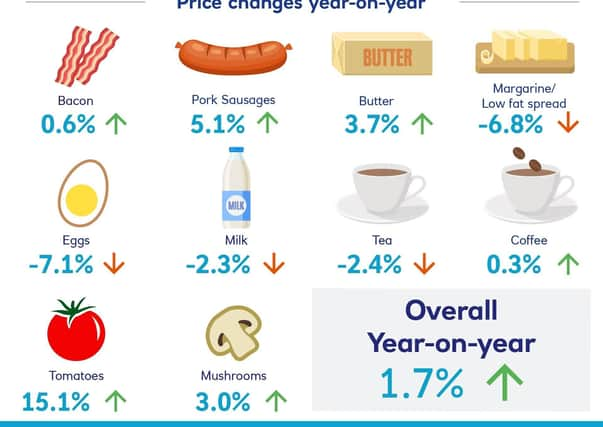Bank’s Ulster fry index rises 1.7%


For the past 13 years, Mr Ramsey has published his annual gauge of the cost of the items that make up a traditional cooked breakfast to help highlight the continuing vital role of the local agri-food sector and to engage the public in food economics.
What the latest Ulster Bank Ulster Fry Index tells us is that whilst the overall Index is up by 1.7% on the same time last year, the pandemic, the UK’s exit from the EU, and an unpredictable climate have had divergent impacts on the costs of individual items.
Advertisement
Advertisement
Most notably, whilst the price of tomatoes has risen 15% in the last year, the cost of eggs has fallen over 7%. The latter is believed to be linked to an oversupply due to restrictions on the operation of the hospitality sector, whilst tomato prices have been impacted by a poor harvest and long winter.


Meanwhile the price of sausages is up 5.1% and the price of butter is up 3.7%, believed to be in part related to Brexit. Once the NI Protocol is implemented in full, it is anticipated that the additional costs of more bureaucracy will result in higher food prices. All prices in the index are based on the latest figures from the ONS Retail Prices Index (RPI).
This year’s rise in the Index follows two consecutive years of falls, but the long-term trend is very much upwards. The Ulster Fry Index is 6.5 percent higher than it was five years ago and 23 percent higher than it was at the time of the last recession in 2008.
Commenting, Richard Ramsey says: “The Ulster Bank Ulster Fry Index is intended to be a way to engage consumers in economics and to help communicate what’s happening with indicators like inflation. It is also a way of highlighting the important role of our agri food sector, which brings us our bacon, eggs, butter and much more, and to create understanding of how the economics of the agri-food sector work.
Advertisement
Advertisement
“Previously we had two consecutive years of falls in the index, perhaps helping ease the pressure on consumers’ pockets. But that trend didn’t continue for a third year due to some of the challenges that have been experienced in the last 12 months. As the food supply chain grappled with the impact of Covid-19, it faced increased costs to do so, and these increased costs will have found their way into the prices of the goods we buy. On the other hand, with the hospitality sector shuttered for a prolonged period of time, this led to an oversupply of eggs which has seen prices go down.”
Mr Ramsey adds that consumers won’t want to see the price of their Ulster fry increase, but that farmers haven’t been celebrating much either.
He points out: “Total income from farming (TIFF) in Northern Ireland rose by more than a third last year as farmers played such a crucial role in feeding people during the pandemic. But as my colleague Cormac McKervey, Ulster Bank’s agriculture expert, has been highlighting, the latest figures show that whilst average farm business income was up an average of 27%, this didn’t translate into farm profit due to the hike in input costs throughout the year, particularly in relation to feed, fertilizer and fuel costs. So, whilst the prices paid by consumers for a range of items rose, this money wasn’t going into farmer’s pockets as their profits were effectively squeezed. In 2021, the likelihood is that the prices consumers pay for a range of food items will continue to rise.
“But with improved farm prices particularly in milk and beef so far in 2021, it’s likely this year will show an improvement in both farm income and farm profit.”
Ulster Bank Ulster Fry Index (year-on-year):
· Overall Index: +1.7%
· Tomatoes: +15.1%
· Back Bacon: +0.6%
· Pork Sausages: +5.1%
· Butter: +3.7%
· Margarine/low fat spread: -6.8%
· Eggs: -7.1%
· Milk: -2.3%
· Tea: -2.4%
· Coffee: + 0.3%
· Mushrooms: +3.0%